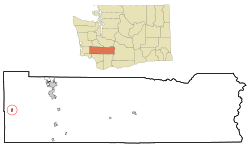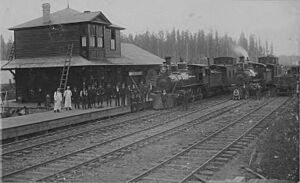Pe Ell, Washington facts for kids
Quick facts for kids
Pe Ell, Washington
|
|
|---|---|

Location of Pe Ell, Washington
|
|
| Country | United States |
| State | Washington |
| County | Lewis |
| Area | |
| • Total | 0.60 sq mi (1.55 km2) |
| • Land | 0.59 sq mi (1.53 km2) |
| • Water | 0.01 sq mi (0.02 km2) |
| Elevation | 420 ft (128 m) |
| Population
(2020)
|
|
| • Total | 642 |
| • Density | 1,142.13/sq mi (440.62/km2) |
| Time zone | UTC−8 (Pacific (PST)) |
| • Summer (DST) | UTC−7 (PDT) |
| ZIP code |
98572
|
| Area code | 360 |
| FIPS code | 53-53930 |
| GNIS feature ID | 1507338 |
Pe Ell is a small town in Lewis County, Washington, United States. In 2020, about 642 people lived there. It's a quiet place with a rich history, especially linked to the early days of railroads and logging in the Pacific Northwest.
Contents
The Story Behind the Name Pe Ell
The town of Pe Ell has an interesting name, but no one is completely sure how it got it! One idea was to name it Mauermanna, after an early settler named Joe Mauermann. But he didn't want the honor.
Different Ideas for the Name
There are a few popular stories about how "Pe Ell" came to be:
- Pronouncing Pierre: The most common story says the name comes from local Native Americans trying to say the name of an early French-Canadian settler, Pierre Charles. He used to work for the Hudson's Bay Company. They found "Pierre" hard to say, and it sounded more like "Pe Ell" to them.
- Initials of a Couple: Another idea is that "P" and "L" were the first letters of Pierre Charles and his Native American wife's names. These initials then became the town's name.
- Charlie Pershell's Name: A different story suggests a Frenchman named Charlie Pershell settled in the area. Native Americans found the "sh" sound in "Pershell" difficult, so it became "Pe Ell."
- Railroad Map Code: One last story says that a railroad map simply marked the spot as "PL," and that turned into the name.
No matter which story is true, the name "Pe Ell" has a unique history!
Pe Ell's Past: A Look at Its History
Pe Ell grew a lot because of its rich natural resources. The area had plenty of timber (trees) and good land for farming.
Early Growth and the Railroad
In 1897, the North Pacific Railway built a train station in Pe Ell. This helped the town grow even more. By 1907, Pe Ell had about 1,000 people, which is more than today! Farmers, millworkers, and loggers came to the town for work.
A Busy Town in the Early 1900s
By 1909, Pe Ell was a busy place. It had many businesses, including:
- A bank
- Three dry goods stores (selling fabric and clothing)
- Two general stores (selling a bit of everything)
- Three grocery stores
- Two barber shops
- Five saloons
- Four hotels
- A newspaper
- A blacksmith (someone who works with metal)
- Even an opera house for entertainment!
Pe Ell officially became a town on March 9, 1906.
The Rock Creek Sanatorium
In the 1930s, Pe Ell was home to the Rock Creek sanatorium. This was a special hospital for people with tuberculosis, a serious lung illness. It was managed by Dr. Angus MacMillan.
The Great Coastal Gale of 2007
In 2007, a huge storm called the Great Coastal Gale of 2007 hit the area. The Chehalis River near Pe Ell rose about 50 feet (15 meters)! This flood damaged the town's water supply system, which was carried over the historic Weyerhaeuser Pe Ell Bridge. It cost a lot of money to fix the water pipes. For a short time, the town even thought about stopping its local government because of the high repair costs.
Where is Pe Ell? Geography and Location
Pe Ell covers about 0.59 square miles (1.53 square kilometers) of land.
Connecting Roads
State Route 6 goes right through the town. This road connects Pe Ell to Chehalis to the east and Raymond to the west.
Who Lives in Pe Ell? Demographics
| Historical population | |||
|---|---|---|---|
| Census | Pop. | %± | |
| 1910 | 838 | — | |
| 1920 | 861 | 2.7% | |
| 1930 | 891 | 3.5% | |
| 1940 | 825 | −7.4% | |
| 1950 | 787 | −4.6% | |
| 1960 | 593 | −24.7% | |
| 1970 | 582 | −1.9% | |
| 1980 | 617 | 6.0% | |
| 1990 | 547 | −11.3% | |
| 2000 | 657 | 20.1% | |
| 2010 | 632 | −3.8% | |
| 2020 | 642 | 1.6% | |
| U.S. Decennial Census 2020 Census |
|||
Pe Ell's Population in 2010
According to the 2010 census, there were 632 people living in Pe Ell.
- Most residents (91.3%) were White.
- Some residents were Native American (3.2%) or from other races.
- About 4.3% of the population was Hispanic or Latino.
There were 259 households in the town. About 32.8% of these households had children under 18 living with them. The average age of people in Pe Ell was 40 years old.
Fun Things to Do: Arts, Culture, and Recreation
Historic Places in Pe Ell
Pe Ell was once home to the Holy Cross Polish National Catholic Church. This church was built in 1916 and was special because it was the only Polish church of its kind in Washington state. Sadly, the building was taken down in 2010 because it was in bad shape and there wasn't enough money to fix it.
Parks and Outdoor Fun
Pe Ell is a great place for outdoor activities!
The Pe Ell River Run
The town is the starting point for the Pe Ell River Run. This fun event began in 1978 as a birthday celebration among friends. People build or buy water crafts and float down the Chehalis River. The journey ends at Rainbow Falls State Park, where riders can go over a small waterfall.
Willapa Hills Trail
The Willapa Hills Trail also goes through Pe Ell. This trail is perfect for walking, biking, or even horseback riding, letting you explore the beautiful natural surroundings.
Learning in Pe Ell: Education
The Pe Ell School District provides public education for students from preschool all the way to 12th grade. All the students attend school on one campus. Students from Pe Ell and nearby communities like Doty and Dryad come here to learn.
History of Pe Ell Schools
- First Schoolhouse: The very first public school building in Pe Ell was a one-room school built in 1882. It was made of cedar and paid for by donations. Only twelve students attended that first year!
- Growing Schools: As more people moved to Pe Ell, the school needed to grow. A new, bigger Central school was built starting in 1892. It was expanded in 1913, and a gym was added in 1921.
- Modern Campus: A wing for agricultural classes was added in 1936. By the end of 1952, a combined elementary and high school was finished. It had a library and athletic fields.
Sports Success
Pe Ell High School has had some great sports teams!
- In 2010, the boys' basketball team and the girls' softball team both won state championships.
- The girls' softball team won another state title in 2012.
- In 2017, they won a combined championship with Willapa Valley.
See also
 In Spanish: Pe Ell (Washington) para niños
In Spanish: Pe Ell (Washington) para niños


